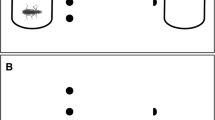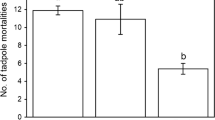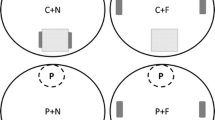Abstract
The ability of bronze frogRana temporalis tadpoles (pure or mixed parental lines) to assess the profitability of food habitats and distribute themselves accordingly was tested experimentally using a rectangular choice tank with a non-continuous input design. Food (boiled spinach) was placed at two opposite ends of the choice tank in a desired ratio (1:1, 1:2 or 1:4) to create habitat A and B. The tadpoles in Gosner stage 28–33, pre-starved for 24 h, were introduced in an open ended mesh cylinder placed in the center of the choice tank, held for 4 min (for acclimation) and then released to allow free movement and habitat selection. The number of tadpoles foraging at each habitat was recorded at 10, 15, 20, 25 and 30 min time intervals. The actual suitability,S i (the food available in a habitat after colonization of tadpoles) of each habitat was obtained from the equationS i =B i−f i (d i) whereB i is basic suitability (amount of food provided at each habitat before release of tadpoles),f i is the rate of depletion of food (lowering effect) with introduction of each tadpole, andd i is the density of tadpoles in habitati. The expected number of tadpoles at each habitat was derived from the actual suitability. With no food in the choice tank, movement of the tadpoles in the test arena was random indicating no bias towards any end of the choice tank or the procedure. In tests with a 1:1 food ratio, the observed ratio of tadpoles (11.71: 12.28) was comparable with the expected 12:12 ratio. The observed number of tadpoles in the habitats with a 1:2 food ratio was 8.71:15.29 and 7.87:16.13 for pure and mixed parental lines respectively. In both cases, the observed ratios were close to the expected values (7:17). Likewise, in experiments with a 1:4 food ratio, the observed number of tadpoles in the two habitats (10.78:37.22) did not differ significantly from the expected ratio of 7:41. In all tests, the number ofR. temporalis tadpoles matched ideally with habitat profitability (undermatching indexK ≜ 1. The study shows that tadpoles of the bronze frog exhibit an ideal free distribution while foraging regardless of whether they are siblings or non-siblings in a group, which correlates well with their group living strategy in nature.
Similar content being viewed by others
References
Buxton N E 1984 The importance of food in the determination of the winter flock sites of the shelduck;Wildfowl 32 79–87
Cowie R J 1977 Optimal foraging in great titsParus major;Nature (London) 268 137–139
Donovan R J and Welden A. W 2002Spreadsheet exercises in ecology and evolution (Massachusetts: Sinauer Associates) pp 321–329
Earn D J D and Johnstone R A 1997 A systematic error in tests of ideal free theory;Proc R Soc London B 264 1671–1675
Fraser D F and Sise T E 1980 Observations on stream minnows in a patchy environment: A test of a theory of habitat distribution;Ecology 61 790–797
Fretwell S D and Lucas H L Jr 1970 On territorial behaviour and other factors influencing habitat distribution in birds;Acta Biotheor. 19 16–36
Gill J A, Sutherland W J and Norris L 2001 “Depletion models” can predict shore bird distribution at different spatial scales;Proc. R. Soc. London Ser. B 268 369–376
Godin J J and Keenleyside M H A 1984 Foraging on patchily distributed prey by a cichlid fish (Teleostei, Cichlidae): A test of the ideal free distribution theory;Anim. Behav. 32 120–131
Gosner K L 1960 A simplified table for staging anuran embryos and larvae, with notes on identification;Herpetologica 16 183–190
Grand T C and Dill L M 1997 The energetic equivalence of cover to juvenile coho salmon(Oncorhynchus kisutch): Ideal free distribution theory applied;Behav. Ecol. 8 437–447
Harley A. B 1981 Learning the evolutionary stable strategy;J. Theor. Biol. 89 611–633
Harper D G C 1982 Competitive foraging in mallards: ‘Ideal Free’ ducks;Anim. Behav. 30 575–584
Houston A I and McNamara J M 1986 Switching between resources and the ideal free distribution;Anim. Behav. 35 301–302
Inman A J 1990 Group foraging in starlings: Distribution of unequal competitors;Anim. Behav. 40 801–810
Milinski M 1979 An evolutionarily stable feeding strategy in sticklebacks; Z.Tierpsychol. 51 36–40
Nishimura K 1999 Exploration of optimal giving-up time in uncertain environment: a sit-and-wait forager;J. Theor. Biol. 199 321–327
Parker G A 1970 The reproductive behaviour and the nature of sexual selection inScatophaga stercoraria L (Diptera: Scatophagia) IX Spatial distribution of fertilization rates and evolution of male searching strategy within the reproductive area;Evolution 28 93–108
Parker G A and Sutherland W J 1986 Ideal free distributions when individuals differ in competitive ability: Phenotype-limited ideal free models;Anim. Behav. 34 1222–1242
Saidapur S K 2001 Behavioral ecology of anuran tadpoles: The Indian scenario;Proc. Indian Natl. Sci. Acad. B67 311–322
Sutherland W J 1982 Spatial variation in the predation of cockles by oystercatchers at Traeth Melynog, Anglesey II. The pattern of mortality;J. Anim. Ecol. 51 491–500
Sutherland W J 2002 Ideal free distribution; inEncyclopedia of evolution (ed.) M Pagel (New York: Oxford University Press) pp 557–558
Sutherland W J and Parker G A 1992 The relationship between continuous input and interference models of ideal free distributions with unequal competitors;Anim. Behav. 44 345–355
Talbot A J and Kramer D L 1986 Effects of food and oxygen availability on habitat selection by guppies in a laboratory environment;Can. J. Zool. 64 88–93
Tregenza T, Thompson D J and Parker G A 1996 Interference and the ideal free distribution: oviposition in a parasitoid wasp;Behav. Ecol. 7 387–394
Author information
Authors and Affiliations
Corresponding author
Rights and permissions
About this article
Cite this article
Veeranagoudar, D.K., Shanbhag, B.A. & Saidapur, S.K. Foraging behaviour in tadpoles of the bronze frogRana temporalis: Experimental evidence for the ideal free distribution. J. Biosci. 29, 201–207 (2004). https://doi.org/10.1007/BF02703418
Published:
Issue Date:
DOI: https://doi.org/10.1007/BF02703418




